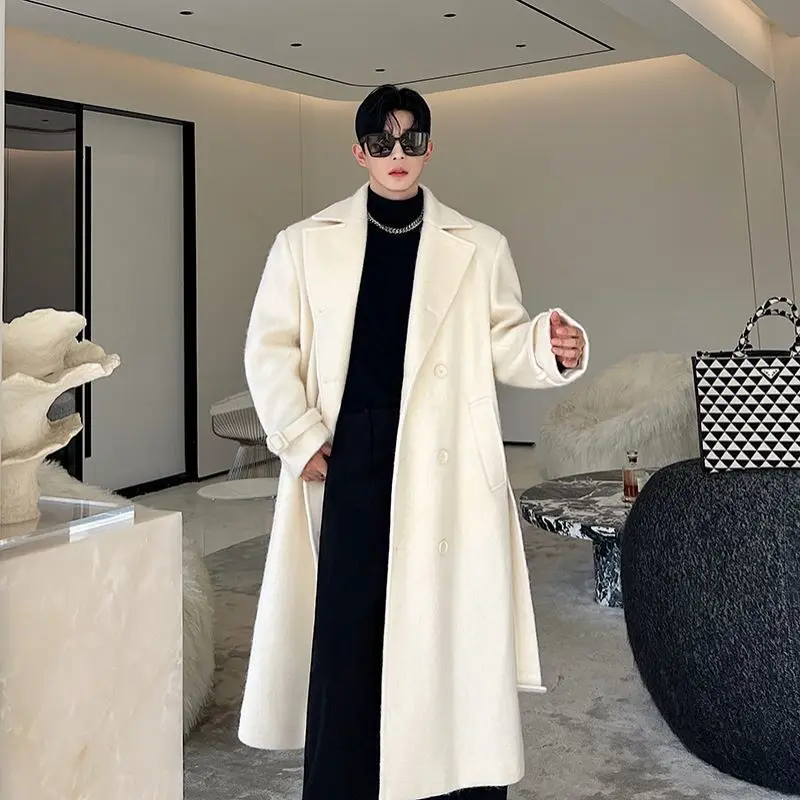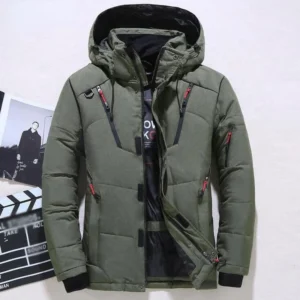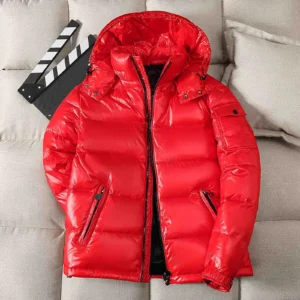Introduction
When winter winds howl and temperatures plummet, a man’s choice of outerwear becomes both a practical necessity and a powerful style statement. Among all winter garments, the long overcoat stands in a class of its own—a timeless symbol of sophistication that has weathered changing fashion trends for generations while continuing to offer unmatched protection from the elements.
The long winter overcoat represents the perfect marriage of form and function. It shields you from biting winds and freezing temperatures while simultaneously elevating your entire appearance with its commanding silhouette. Whether worn over a business suit or paired with casual weekend attire, a well-chosen overcoat transforms an ordinary outfit into something extraordinary.
In this comprehensive guide, we’ll explore everything you need to know about men’s long overcoats—from classic styles and premium materials to finding your perfect fit and caring for your investment piece. Our goal is to help you navigate the world of winter overcoats with confidence, ensuring you select a garment that will serve you faithfully for years to come while making you look and feel your best during the coldest months.
Why Long Overcoats Reign Supreme in Winter Menswear
The enduring popularity of long overcoats during winter isn’t merely about tradition—it’s about superior functionality combined with unmatched elegance. Here’s why they continue to be essential elements in a well-curated winter wardrobe:
Superior Weather Protection
The defining feature of a long overcoat—its extended length—provides comprehensive coverage that shorter alternatives simply cannot match. By protecting the body from mid-chest to below the knee, these garments create a more complete barrier against winter’s harsh conditions. This extended coverage is particularly valuable when facing strong winds or snowfall, as it prevents cold air from infiltrating underneath.
The difference between short and long coat options becomes most apparent during truly frigid days. While a shorter jacket might leave your thighs and lower body exposed to the elements, a proper long overcoat creates a continuous shield of warmth.
Enhanced Thermal Efficiency
Long overcoats provide significantly better heat retention than their shorter counterparts. The extended fabric creates a larger warm air pocket around your body, functioning as an additional insulating layer. This design is especially effective when temperatures drop below freezing, making winter long coats particularly valuable for commuters and anyone spending extended time outdoors.
Versatility Across Occasions
Perhaps no other winter garment transitions as seamlessly between different settings as the long overcoat. For business environments, it provides a polished protective layer that complements formal attire without compressing or damaging suits underneath. For evening events, it adds an element of refinement and sophistication. Even in casual contexts, a well-fitted overcoat instantly elevates simple attire while maintaining its practical warming properties.
This versatility makes a quality overcoat one of the most practical investments in a man’s wardrobe—a single garment that serves multiple purposes throughout the winter season.
Essential Long Overcoat Styles for Winter
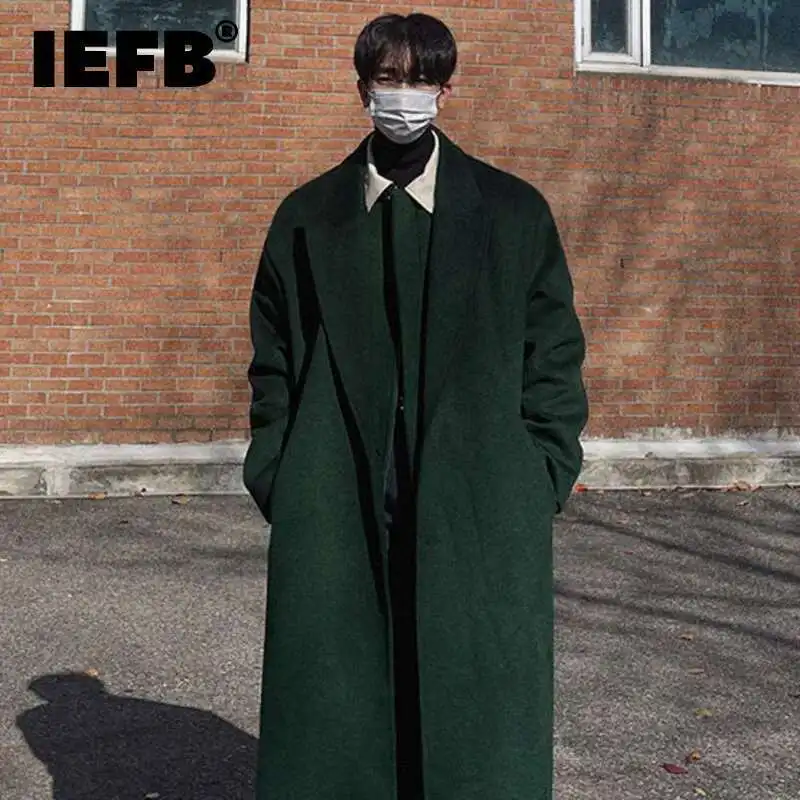
Winter overcoats come in several distinct styles, each with its own heritage, characteristics, and ideal usage scenarios. Understanding these differences helps you select the perfect coat for your lifestyle and personal aesthetic.
The Chesterfield Overcoat
The Chesterfield represents the quintessential business overcoat—clean-lined, sophisticated, and eternally relevant. Characterized by its single-breasted front, notch lapels, and typically knee-length cut, this style provides a sleek silhouette that complements professional attire beautifully. Most commonly crafted from fine wool materials, the Chesterfield typically features a center back vent for ease of movement.
Best suited for: Business environments, formal occasions, and situations where refined simplicity is valued. The Chesterfield works particularly well for men with average to slim builds who prefer an elegant, understated appearance.
The Double-Breasted Overcoat
For maximum warmth and commanding presence, the double-breasted overcoat stands unrivaled. With its overlapping front panels secured by two parallel columns of buttons, this style provides superior wind protection and thermal efficiency. Traditionally featuring peak lapels that create a strong shoulder line, the double-breasted design makes a bold style statement while offering practical benefits.
The additional fabric across the chest and the higher buttoning point create an extra layer of insulation precisely where the body needs it most. This makes double-breasted models particularly effective in extremely cold conditions while providing a distinguished silhouette.
Best suited for: Colder climates, formal settings, and men who appreciate classic elegance with authoritative presence. The style particularly flatters taller men and those with broader shoulders.
The Polo Coat
Originally designed for polo players between matches, the Polo coat combines casual luxury with serious winter protection. Distinguished by its wrap styling, belted waist, patch pockets, and often crafted from camel hair, this coat brings a relaxed sophistication to winter wear. Its double-breasted front and Ulster collar (which can be turned up against the wind) make it both practical and distinctive.
Best suited for: Smart-casual environments, weekend outings, and situations requiring both warmth and a touch of refined sportiness. The belted waist makes this style adaptable to various body types.
The Ulster Coat
When facing truly challenging winter conditions, the Ulster coat provides maximum protection. This rugged style features a cape-like shoulder overlay, notched collar that can be fully fastened at the neck, and often includes a detachable hood. Traditionally made from heavy tweed or similar durable fabrics, the Ulster typically extends to mid-calf and may include a half-belt at the back.
Best suited for: Severe weather conditions, country settings, and situations where function takes precedence over formality. The substantial nature of this coat makes it ideal for taller men or those with larger frames.
The Military-Inspired Coat
Drawing inspiration from military heritage, these coats feature structured designs with distinctive functional details like epaulets, throat latches, and regimented button patterns. Often seen in navy or black wool, these coats combine disciplined tailoring with practical features developed for service in harsh conditions.
Best suited for: Men who appreciate historical details and structured garments with a commanding presence. The tailored nature of these coats works well across most body types.
Contemporary Interpretations
Modern designers continue to reinterpret traditional overcoat styles, often blending elements from different classics or introducing technical fabrics and features. These contemporary versions might feature cleaner lines, minimalist detailing, or unexpected texture combinations while maintaining the essential protective qualities of their predecessors.
Finding Your Perfect Length: A Guide to Overcoat Proportions
The question of proper coat length isn’t merely aesthetic—it directly impacts both the functionality and visual balance of your winter outerwear. Proper coat length contributes significantly to warmth, mobility, and overall appearance.
Standard Length Options
Above-knee length (36-38 inches): The shortest acceptable length for a true overcoat, providing moderate weather protection while maximizing mobility. This length works well for milder winters or urban environments with frequent car transportation.
Knee-length (40-42 inches): The classic and most versatile length, balancing protection and ease of movement. This traditional option provides good coverage while remaining practical for daily commuting and various activities.
Below-knee length (44-46 inches): Offers superior protection in harsh conditions, creating a dramatic silhouette. This extended length is ideal for severe weather and formal occasions where statement-making elegance is appropriate.
Full-length (48+ inches): The most protective and formal option, extending to the lower calf or ankle. This dramatic length provides maximum coverage but requires consideration of proportions and practicality.
Height Considerations
Your height plays a crucial role in determining the most flattering overcoat length. The relationship between height and coat length follows certain principles:
For men under 5‘8”: Shorter coat lengths (above-knee or just at the knee) often work best, preventing the overwhelming effect that longer coats might create. The goal is to maintain visual proportion without sacrificing protection.
For men 5‘8” to 6‘1”: Most standard lengths work well, with knee-length providing the most versatile option. This middle range offers flexibility to choose based on personal preference and specific needs.
For men over 6‘1”: Longer coat lengths become increasingly flattering, as taller men can carry the additional fabric without appearing overwhelmed. Below-knee or even full-length options can create a striking and balanced appearance.
Contrary to common misconceptions, shorter men can absolutely wear long coats—the key is ensuring the coat length makes you appear taller rather than shorter. This is achieved through proper proportioning and careful attention to where the coat breaks across the leg.
Climate Considerations
Your local winter conditions should significantly influence your length choice:
- Mild winters: Shorter lengths (above-knee) may provide sufficient protection while offering greater mobility.
- Moderate winters: Knee-length coats balance protection and practicality for most common winter conditions.
- Severe winters: Below-knee or full-length coats offer superior protection when facing extreme cold, strong winds, or heavy precipitation.
For shorter men seeking optimal coat lengths, the key is finding balance between protection and proportion. A well-chosen coat should end at a visually harmonious point that doesn’t cut the body in an unflattering way, typically just at or slightly above the knee.
Winter Overcoat Materials: Balancing Warmth and Wearability
The material of your winter overcoat determines not only its appearance but also its thermal properties, durability, and maintenance requirements. Understanding different fabric options helps you make an informed choice based on your specific needs and local climate conditions.
Premium Wool Varieties
Wool remains the gold standard for winter overcoats, offering natural insulation, breathability, and classic appearance. However, not all wools are created equal:
Melton Wool
This densely woven, smooth-finished wool undergoes significant fulling (a process involving heat, moisture, and pressure) to create an exceptionally tight, weather-resistant fabric. Melton provides excellent wind resistance and substantial warmth, making it ideal for severe winter conditions. Its smooth surface also resists pilling and maintains appearance over time.
Tweed
Characterized by its textured appearance and often featuring distinctive patterns like herringbone or check, tweed coats offer robust protection with heritage appeal. Originally developed for country use, tweeds combine substantial warmth with excellent moisture resistance. Modern iterations range from heavyweight traditional versions to lighter, more refined urban adaptations.
Cashmere Wool
For those seeking the ultimate in luxury, cashmere overcoats provide exceptional softness, lightweight warmth, and sophisticated drape. Harvested from cashmere goats, this premium fiber offers insulation that’s approximately eight times warmer than sheep’s wool despite being significantly lighter. The tradeoff comes in higher cost and typically greater care requirements.
Camel Hair
With its distinctive golden-tan color and natural water resistance, camel hair offers excellent insulation with unique visual appeal. Slightly less formal than other wool options, camel hair coats provide substantial warmth while being lighter than many comparable wools, creating a comfortable wearing experience even in heavy garments.
Understanding Fabric Weight
A crucial but often overlooked aspect of winter coat selection is fabric weight, typically measured in grams per square meter (GSM) or ounces:
Light (400-500 GSM/11-14 oz): Suitable for mild winters or indoor-outdoor transitions; provides moderate warmth while maximizing comfort and mobility.
Medium (500-600 GSM/14-17 oz): Versatile weight appropriate for average winter conditions; balances protection with wearability.
Heavy (600+ GSM/18+ oz): Designed for severe winter environments; offers maximum protection but with increased weight and sometimes reduced mobility.
For truly cold environments, look for coats in the upper weight ranges, as the additional fabric density significantly improves insulating properties.
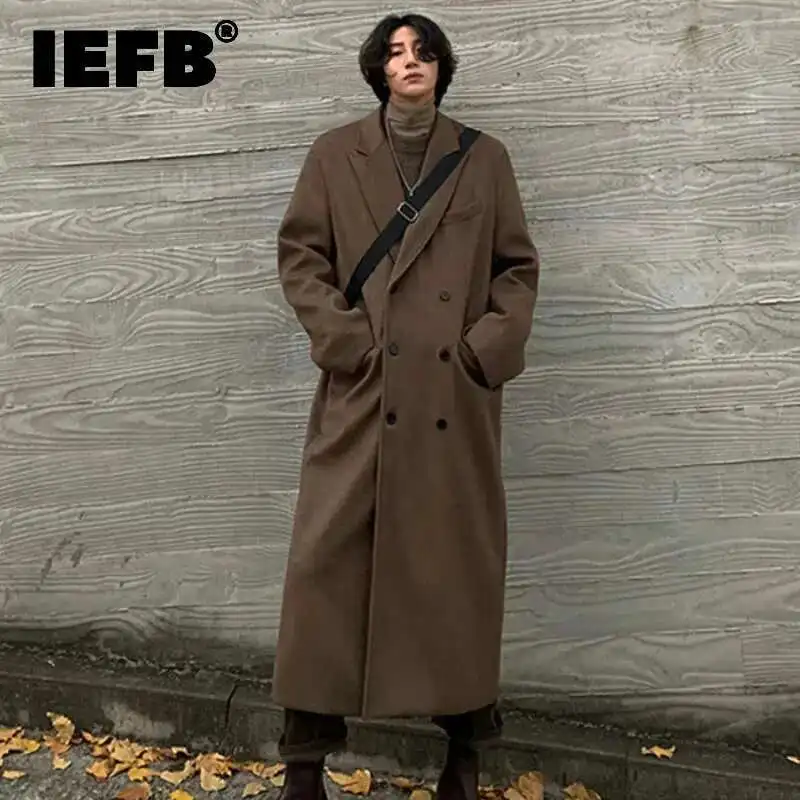
Enhanced Performance Features
Modern fabric technologies have introduced performance enhancements that improve traditional materials:
- Tightly woven shells: Special weaving techniques create windproof barriers without synthetic membranes.
- Water-resistant treatments: Natural wool can be treated to enhance its innate water-repelling properties without compromising breathability.
- Fabric blends: Small percentages of synthetic fibers (often 10-20%) can significantly improve durability and wrinkle resistance.
When evaluating material options, consider both the typical temperatures you’ll face and your personal comfort preferences. Those who run warm might prefer lighter weight options, while those susceptible to cold may prioritize maximum insulation properties.
Mens Heavy Winter Coat, Mens Insulated Coat, Mens Parka Coat
Price range: $175.52 through $237.36 Select options This product has multiple variants. The options may be chosen on the product pageMens Big and Tall Winter Coats, Mens Down Coat, Mens Hooded Winter Coat, Mens Puffer Coat
Price range: $126.44 through $217.01 Select options This product has multiple variants. The options may be chosen on the product pageMens Big and Tall Winter Coats, Mens Hooded Winter Coat
Price range: $80.32 through $106.68 Select options This product has multiple variants. The options may be chosen on the product pageMens Cashmere Overcoat, Mens Hooded Winter Coat, Mens Wool Blend Coat
Price range: $128.72 through $139.68 Select options This product has multiple variants. The options may be chosen on the product pageMens Hooded Winter Coat, Mens Insulated Coat, Mens Puffer Coat, Mens Quilted Coat
Price range: $139.88 through $177.72 Select options This product has multiple variants. The options may be chosen on the product pageMens Black Overcoat, Mens Black Wool Coat, Mens Wool Overcoat
$339.18 Select options This product has multiple variants. The options may be chosen on the product page
The Anatomy of a Quality Winter Overcoat
Understanding the construction elements of an overcoat helps you evaluate quality and make informed purchasing decisions. Both visible exterior features and hidden interior construction contribute to a coat’s performance, comfort, and longevity.
Exterior Construction Elements
Lapel Styles
- Notch lapels: The most common and versatile style, featuring a visible notch where collar meets lapel. This traditional option works well for business and casual contexts.
- Peak lapels: More formal and dramatic, with points that “peak” upward. Common on double-breasted coats, they create a stronger shoulder line and more formal appearance.
- Ulster collar: A wide, convertible collar that can be turned up and fastened at the neck for maximum protection. Typically found on more casual or country-inspired styles.
Closure Systems
Single-breasted coats offer cleaner lines and lighter weight, while double-breasted designs provide superior warmth through overlapping fabric layers. The additional fabric across the chest creates an extra insulation barrier precisely where it’s most beneficial.
Vent Options
- Center vent: A single slit at the back center offering moderate mobility
- Side vents: Two slits at the back sides providing greater freedom of movement, especially when sitting
- No vent: Creates the cleanest silhouette but restricts movement most significantly
Shoulder Construction
Well-constructed shoulders should follow your natural shoulder line without excessive padding or structure. The shoulder seam should rest at or just slightly beyond your actual shoulder edge for optimal fit and appearance.
Interior Construction Features
Lining Materials
Quality overcoats feature full linings that enhance comfort, facilitate easy wearing over other garments, and protect the main fabric:
- Bemberg/Cupro: A premium option offering breathability, durability, and smooth glide over other clothing
- Silk: Luxurious but less durable than modern alternatives
- Flannel-backed linings: Provide additional insulation in extreme conditions
Canvas Construction
Superior overcoats utilize floating canvas construction—layers of natural materials (typically horsehair, linen, or cotton canvas) that are hand-stitched rather than glued to the outer fabric. This construction allows the coat to mold to your body over time while maintaining structural integrity.
In contrast, fused construction (where interlining is glued to the outer fabric) offers lower production costs but typically results in less comfortable garments with shorter lifespans.
Insulation Methods
Different approaches to insulation affect both warmth and wearability:
- Traditional wool interlining: Natural insulation layer between outer fabric and lining
- Thinsulate or similar modern insulation: Lightweight synthetic options offering excellent warmth-to-weight ratio
- Quilted insulation: Diamond or channel quilting that secures insulating material while creating distinctive interior appearance
Critical Winter Performance Features
- Storm collars: Additional collar pieces that provide neck protection
- Throat latches: Hidden or visible tabs that secure the collar closed at the neck
- Inner wind guards: Fabric barriers behind the front closure preventing cold air infiltration
- Pocket construction: Exterior pockets should be securely anchored to the coat body, not merely to the lining, for durability
Quality construction is evident in consistent, tight stitching (typically 10-12 stitches per inch), properly aligned patterns at seams, and reinforcement at stress points like pocket corners.
Achieving the Perfect Fit: How Your Winter Overcoat Should Feel
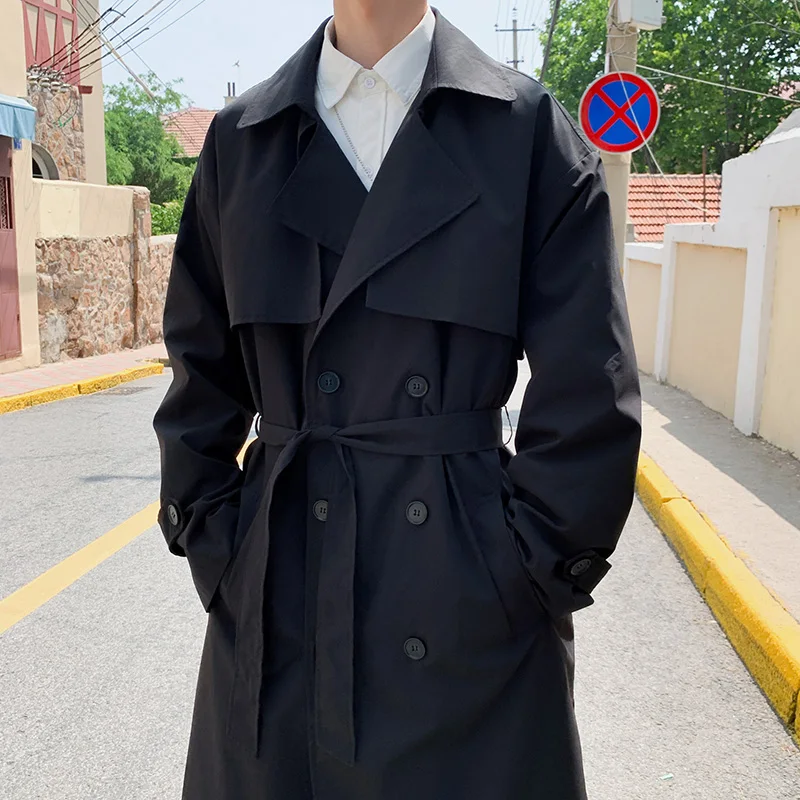
A properly fitted overcoat enhances both comfort and appearance. Unlike many garments worn directly against the body, overcoats require specific fit considerations to accommodate layering while maintaining a flattering silhouette.
The Layering Principle
The fundamental rule of overcoat fitting is allowing appropriate space for underlying garments without excessive bulk. Your coat should comfortably accommodate your typical winter layers—whether that’s a suit and dress shirt or heavy sweaters—while maintaining a clean line.
When trying on overcoats, wear your typical winter clothing underneath to ensure realistic fit assessment. A properly sized coat will allow full range of motion without binding at shoulders or chest, even with layers.
Critical Fit Points
Shoulder Alignment
The overcoat’s shoulder seams should align with or extend just slightly beyond your natural shoulders. This provides enough room for suit jackets or sweaters underneath while maintaining proper proportion. Too narrow, and the coat will pull and restrict movement; too wide, and it will appear oversized and sloppy.
Chest and Torso Comfort
When buttoned, the coat should close smoothly without pulling or creating an “X” shape across the chest. You should be able to fit a flat hand between your layered clothing and the coat at chest level—this indicates appropriate room without excessive volume.
The perfect winter coat length contributes significantly to overall fit impression. The coat should fall straight from shoulders without flaring excessively, creating a clean vertical line that flatters your body type.
Sleeve Length
Proper sleeve length allows approximately ½ inch of suit jacket sleeve to show, or should hit at the base of your thumb when arms are relaxed if worn primarily with casual clothing. This length consideration for different body types ensures both functionality and proper proportion.
Overall Length
As discussed earlier, length should be selected based on both height and intended use. The critical factor is ensuring the coat’s length creates visual balance with your overall proportions.
Common Fit Problems and Solutions
Shoulder divots: Visible dents or wrinkles just below the shoulder seam indicate the coat is too tight across shoulders. Size up or try a different cut.
Collar gap: Space between your neck and the coat collar when standing normally suggests fit issues in the upper back or shoulders. Proper fit should show the collar resting gently against your shirt collar.
Button strain: Visible pulling around buttoned areas indicates insufficient room. Either size up or try a different cut with more generous chest dimensions.
Excessive fabric pooling: Material gathering at the lower back suggests the coat is too large through the body. Consider sizing down or exploring more fitted styles.
Fit Variations to Consider
- Classic fit: Provides generous room throughout for maximum layering capacity and traditional appearance
- Slim fit: Offers a more tailored silhouette with less fabric through the body
- Relaxed fit: Features expanded chest and shoulder dimensions for athletic builds
Essential Alterations
Most overcoats can be adjusted for improved fit. Common alterations include:
- Sleeve shortening: Relatively simple and inexpensive
- Waist suppression: Creating a more defined silhouette through the midsection
- Button repositioning: Minor adjustments to improve front closure appearance
However, significant structural elements typically cannot be easily altered:
- Shoulder width and construction
- Overall length
- Lapel style and dimensions
When purchasing, prioritize proper fit in these areas, as they’re challenging or impossible to modify successfully.
Styling Your Winter Overcoat: From Business to Casual
A well-chosen overcoat serves as a versatile cornerstone of winter wardrobes, adaptable across various settings with thoughtful styling. The relationship between coat length and style creates different aesthetic impressions and appropriateness levels for different contexts.
Business and Formal Attire Pairings
For professional and formal settings, coordinate your overcoat with underlying business attire:
With suits: Choose coats in neutral tones (navy, charcoal, black) that complement rather than match your suit exactly. This creates sophisticated contrast while maintaining professional coherence.
Color combinations: Navy overcoats pair beautifully with gray suits, while camel coats create striking contrast with navy or charcoal suits. Black overcoats offer maximum versatility across formal environments.
Formal accessories: Elevate business styling with leather gloves, solid or subtly patterned scarves, and structured leather portfolios or briefcases. These refined elements complement the overcoat’s formal nature.
For maximum impact in business settings, ensure proper fit and appropriate length, as these factors significantly influence the coat’s professional appearance.
Smart Casual Combinations
Overcoats transition effectively to smart casual contexts when paired with appropriate supporting elements:
With sport coats: Pair structured overcoats with textured sport coats and dark denim or wool trousers for sophisticated but relaxed appearance. The contrast between casual and formal creates interesting visual tension.
Color and texture: Introduce rich colors (burgundy, bottle green, camel) and textured fabrics (tweed, flannel) to soften the formality. These elements create a more approachable aesthetic while maintaining refinement.
Business casual coordination: Layer overcoats over fine merino sweaters, Oxford shirts, and well-fitted chinos for office environments with relaxed dress codes. This creates a pulled-together look without full formality.
The key to successful smart casual styling is balancing the inherent formality of the overcoat with more relaxed supporting pieces while maintaining overall coherence.
Weekend and Casual Wear
Even traditionally formal overcoat styles can be effectively dressed down for casual settings:
With denim: Pair structured overcoats with dark, well-fitted jeans and quality footwear (leather boots or clean sneakers) for an elegant casual approach. The contrast between the refined coat and casual denim creates appealing visual interest.
Casual layers: Layer overcoats over hoodies, chunky knit sweaters, or casual button-downs for relaxed weekend wear. These unexpected combinations create contemporary, approachable styling.
Relaxed accessories: Introduce casual scarves in bolder patterns, knit beanies, and less structured bags to further casual transformation. These elements help transition the formal overcoat into relaxed contexts.
The contrast between the inherent formality of an overcoat and deliberately casual supporting pieces creates a sophisticated yet approachable appearance perfect for weekend activities.
Effective Accessorizing
Accessories significantly influence how an overcoat reads in different contexts:
Scarf selection: Choose between formal options (fine cashmere, silk, subtle patterns) for business settings and bolder, chunkier varieties for casual wear. The scarf provides both functional warmth and a key style element.
Glove considerations: Match glove formality to context—smooth leather for business, textured leather or knit styles for casual settings. Ensure proper fit with enough room for dexterity but without excess material.
Hat integration: Select headwear that complements both coat style and face shape. Structured felt hats provide formal elegance, while wool beanies or caps offer casual alternatives with maintained sophistication.
When coordinating accessories, create cohesion through complementary colors and textures rather than exact matching, which can appear contrived.
What to Look For: Assessing Quality and Value
Identifying quality in winter overcoats requires attention to specific construction details and material characteristics that indicate superior craftsmanship and durability.
Hallmarks of Superior Construction
Stitching Details
- Tight, consistent stitching: Look for even, close-spaced stitches (ideally 10-12 per inch) with no loose threads or irregularities
- Hand-finished buttonholes: Properly executed buttonholes with tight, consistent stitching that fully secures the fabric edges
- Pattern matching: Carefully aligned patterns at seams, particularly visible on checked or striped fabrics
Fabric Quality Assessment
- Dense weave: Hold the fabric up to light—minimal light penetration indicates tighter weave and better insulation
- Recovery test: Gently pinch and release the fabric—quality materials should return to original state quickly with minimal wrinkling
- Even color: Consistent coloration throughout, without fading or uneven dyeing
Hardware Elements
- Natural material buttons: Horn, corozo nut, or high-quality synthetics that resist cracking
- Secure button attachment: Reinforced shanks and proper thread wrapping
- Smooth-operating zippers (if present): Heavy-duty zips with proper backing to prevent fabric catching
Price-Quality Relationship
Understanding price brackets helps set realistic expectations for construction quality:
Entry-level ($100-$300): Typically machine-made with fused construction, synthetic blends or lower-grade wools, and basic detailing. These coats provide adequate function but typically show wear more quickly and offer less refined appearance.
Mid-range ($300-$700): Better materials including quality wool blends, improved construction with partial hand-finishing, and more attention to details like lining and button quality. These represent good value for many consumers, balancing quality with accessibility.
Premium ($700-$1,500): High-grade natural materials, significant hand-construction elements, superior linings, and refined detailing throughout. These garments offer noticeably better drape, comfort, and longevity.
Luxury ($1,500+): Exceptional materials (premium cashmere, vicuña, etc.), extensive hand-tailoring, and superior finishing throughout. These investment pieces offer maximum refinement and durability when properly maintained.

Critical Quality Indicators
When evaluating overcoats, prioritize these factors that significantly impact performance and longevity:
- Fabric composition: Natural fibers (particularly wool) provide superior insulation, breathability, and aging characteristics
- Construction method: Canvas construction offers better drape, comfort, and longevity than fused alternatives
- Seam reinforcement: Double stitching or tape reinforcement at stress points
- Lining quality: Smooth, durable lining properly attached with sufficient ease for movement
While compromise may be necessary within budget constraints, these elements represent areas where quality directly affects performance and longevity.
Value Assessment Strategies
Consider these approaches when evaluating cost-to-value ratio:
- Cost-per-wear calculation: Divide purchase price by estimated number of wears over the garment’s lifetime
- Maintenance requirements: Factor in dry cleaning and storage costs when comparing options
- Versatility assessment: More versatile coats that work across multiple settings offer better value than highly specialized options
Remember that true value encompasses both initial quality and long-term performance rather than simply purchase price.
Where to Buy: Finding Your Perfect Winter Overcoat
Finding the ideal winter overcoat involves navigating various retail channels, each offering distinct advantages and potential drawbacks. Understanding these differences helps you shop more efficiently and effectively.
Department Stores and Multi-Brand Retailers
These traditional shopping venues offer several advantages:
- Broad selection: Multiple brands and styles under one roof allowing direct comparison
- Seasonal sales cycles: Predictable discount periods, typically mid to late winter
- Professional assistance: Access to sales staff who can provide guidance and sizing help
Best approach: Visit during less busy periods to ensure proper attention, try multiple brands to understand fit differences, and leverage knowledgeable staff for recommendations based on your specific needs.
Specialized Menswear Shops
Independent and chain menswear specialists often provide:
- Curated selection: Carefully chosen options reflecting the store’s aesthetic and quality standards
- Deeper product knowledge: Staff typically possess more detailed understanding of construction and materials
- Alteration services: Often offer in-house tailoring for perfect fit
Best approach: Develop relationships with knowledgeable staff who understand your preferences, leverage their expertise for education about quality indicators, and take advantage of personalized service.
Direct-to-Consumer Brands
The growing DTC market offers:
- Value proposition: Often providing higher quality at lower prices by eliminating middlemen
- Focused collections: Typically smaller, more cohesive selections making choices clearer
- Detailed online information: Comprehensive specifications and measurements
Best approach: Thoroughly research sizing information, understand return policies before purchasing, and consider ordering multiple sizes for home try-on if possible.
Vintage and Secondhand Options
For unique pieces or exceptional value:
- Extraordinary materials: Access to fabric qualities rarely found in modern production
- Distinctive styling: Classic details often omitted from contemporary versions
- Potential value: Premium quality at reduced prices for savvy shoppers
Best approach: Learn to identify quality indicators, verify condition thoroughly (especially lining and closure systems), and budget for potential alterations to update fit.
Online Shopping Strategies
When purchasing remotely:
- Detailed measurements: Compare your best-fitting coat’s measurements with provided specifications
- Return policy verification: Ensure flexible returns before purchasing
- Customer reviews: Look for feedback from similar body types
- Material research: Request fabric swatches when available for better understanding of hand and weight
A comprehensive winter coats collection should include detailed specifications and clear photography to facilitate informed remote purchasing.
Seasonal Timing Considerations
Strategic timing can significantly impact selection and value:
- Early season (September-October): Maximum selection but minimal discounting
- Mid-season (November-December): Good selection with occasional promotions
- Late season (January-March): Reduced selection but maximum discounting
For investment pieces, prioritize selection over savings by shopping earlier in the season when size ranges are complete.
Caring for Your Investment: Maintenance and Storage
Proper care dramatically extends the lifespan of quality overcoats, protecting your investment and ensuring optimal appearance and performance for years to come.
Day-to-Day Maintenance
Regular attention prevents minor issues from becoming significant problems:
Brushing routine: Use a quality clothes brush to remove surface dust and debris after each wearing. Brush in the direction of the fabric nap using gentle, consistent strokes.
Spot cleaning: Address spills immediately by blotting (never rubbing) with clean, white absorbent cloth. For persistent spots, use a slightly damp cloth with minimal pressure.
Hanging practices: Store on broad, shaped wooden hangers that support the shoulders properly. Allow space between garments for air circulation and fabric recovery.
Weather management: Allow damp coats to dry naturally at room temperature before brushing or storing. Never place wet wool near direct heat sources, which can cause shrinkage and fiber damage.
For daily care, remember that prevention is more effective than remediation—protect your coat from avoidable exposure to harsh conditions when possible.
Seasonal Cleaning and Storage
Proper end-of-season care prepares your overcoat for extended storage and ensures it’s ready for the next winter:
Professional cleaning: Have coats professionally dry cleaned at season’s end, but not more frequently than necessary as cleaning processes can stress fibers. Ensure cleaners are experienced with premium outerwear.
Storage preparation: Once cleaned, allow the coat to air thoroughly before storage to eliminate all cleaning chemical residues. Use breathable garment bags rather than plastic, which can trap moisture.
Optimal storage conditions: Store in cool, dry environments away from direct sunlight, which can fade fabrics. Cedar elements help deter moths while imparting pleasant aroma.
Moth protection: Use cedar blocks, lavender sachets, or proper moth deterrents rather than mothballs, which leave persistent odors. Ensure garments are clean before storage, as food particles and body oils attract pests.
Proper off-season storage is as important as regular maintenance during the wearing season.
Addressing Common Issues
Prompt attention to developing problems prevents more serious damage:
Button security: Reinforce loosening buttons before they detach completely. This simple preventative measure saves more complicated repairs later.
Seam maintenance: Address small seam separations immediately before they expand. Most tailors can make these minor repairs nearly invisible.
Fabric pilling: Remove pills using a dedicated fabric shaver on the lowest setting, exercising extreme caution to avoid damaging the underlying fabric.
Lining repairs: Address lining tears promptly, as they tend to expand rapidly with continued wear. Quality tailors can replace linings entirely when necessary.
For significant issues or valuable garments, consult specialists in outerwear repair rather than general alteration services.
Professional Maintenance
Know when to seek expert assistance:
Major repairs: Significant tears, extensive lining damage, or collar/lapel issues require professional attention.
Reweaving: For small holes or tears in valuable coats, professional reweaving can create nearly invisible repairs.
Waterproofing: Professional reapplication of water-resistant treatments maintains protection while preserving breathability.
Structural restoration: Expert tailors can sometimes rebuild deteriorated internal structure in vintage or well-worn quality coats.
Quality overcoats can last decades or even generations with appropriate care and occasional professional restoration.
Frequently Asked Questions About Men’s Winter Overcoats
How long should a winter overcoat last?
A quality winter overcoat with proper care should last 5-10 years with regular use, and premium versions can serve reliably for decades. The lifespan depends largely on four factors: initial quality, wear frequency, maintenance practices, and storage conditions. Coats with canvassed construction and natural fiber compositions typically outlast fused alternatives by a significant margin.
Can long overcoats work for shorter men?
Absolutely. Shorter men can wear long overcoats successfully by focusing on proportion rather than arbitrary rules. The key is selecting a coat length that creates vertical lines and avoids cutting the body at unflattering points. Generally, a coat ending just above or at the knee creates the most balanced look, while ensuring shoulders fit properly prevents the “borrowed from someone else” appearance.
Is it better to size up for winter layering?
Quality overcoats are already designed with layering in mind, making significant upsizing unnecessary and potentially counterproductive. Instead of sizing up, look for coats cut with appropriate ease in the chest and shoulders. A properly sized overcoat should comfortably accommodate a suit or sweater underneath while maintaining a clean silhouette. If you find yourself between sizes, the slightly larger option is preferable for winter wear.
Which is warmer: single or double-breasted overcoats?
Double-breasted overcoats typically provide superior warmth due to the overlapping fabric layers across the chest and torso. This double layer creates an additional insulation barrier precisely where the body needs it most. However, fabric weight and composition remain the most significant factors in determining overall warmth. A heavy single-breasted wool coat will offer better insulation than a lighter double-breasted version in most cases.
How often should wool overcoats be cleaned?
Wool overcoats should be professionally cleaned sparingly—typically once per season or when visibly soiled. Wool naturally resists dirt and odors, and excessive cleaning can degrade the fabric over time. Instead, maintain your coat with regular brushing after wearing and spot-cleaning minor marks. Always ensure complete drying before storage, and use professional cleaners experienced with premium outerwear.
Can I wear a long overcoat casually?
Modern styling approaches have made long overcoats increasingly versatile across formality levels. To wear an overcoat casually, focus on creating intentional contrast through more relaxed underlying pieces like jeans, sneakers, or casual knitwear. The juxtaposition of the structured coat with casual elements creates a sophisticated yet approachable aesthetic. Textured fabrics like tweed also transition more easily to casual contexts than smoother, more formal options.
What’s the difference between a topcoat and overcoat?
The distinction primarily involves weight and intended temperature range. Topcoats are typically lighter (under 500 GSM/15 oz), designed for mild to moderate cold, and often feature lighter construction. Overcoats are heavier (over 500 GSM), designed for genuine winter conditions, and usually constructed with more substantial materials throughout. Additionally, overcoats commonly extend to knee-length or beyond, while topcoats may be slightly shorter.
How do I know if the fabric weight is sufficient for my climate?
For moderate winter areas (temperatures typically above freezing), medium-weight fabrics (450-550 GSM/13-16 oz) usually provide adequate protection. For colder regions with temperatures regularly below freezing, heavier fabrics (550+ GSM/16+ oz) become necessary. Those in severe winter climates should look for the heaviest options (600+ GSM/18+ oz) with additional features like wind guards and throat latches. Consider your personal cold sensitivity and typical activity level when evaluating appropriate weight.
Beyond the Basics: Advanced Overcoat Considerations
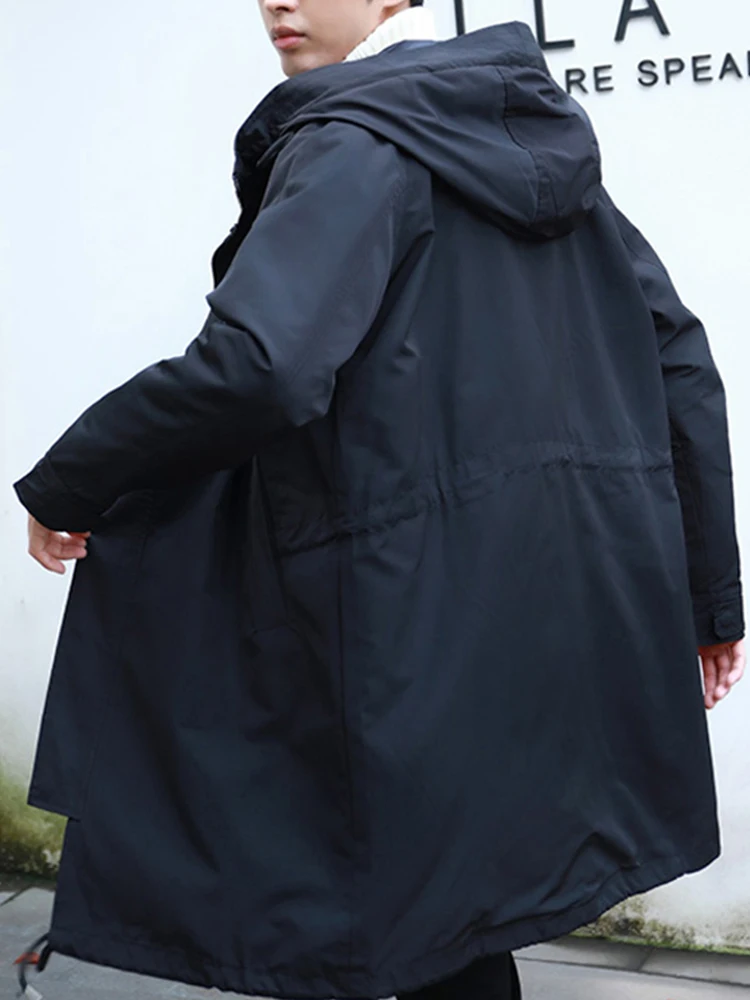
Once you’ve mastered the fundamentals of winter overcoats, exploring more nuanced aspects allows you to refine your collection and develop a more personalized approach to winter outerwear.
Statement Pieces vs. Classic Investments
While versatile, neutral-colored coats form the foundation of a practical wardrobe, considerate addition of statement pieces creates visual interest and personal expression. Strategic balance between timeless black overcoats and more distinctive options maximizes wardrobe flexibility.
For statement pieces, consider:
* Distinctive patterns like bold checks or herringbone
* Unexpected colors such as burgundy, bottle green, or camel
* Unique design details like contrast collars or decorative belting
The key to successful statement coats is ensuring they coordinate with multiple items in your existing wardrobe despite their distinctive nature.
Sustainable and Ethical Considerations
The environmental and social impact of clothing production has become increasingly important to many consumers. In overcoat selection, sustainable approaches include:
- Favoring natural, biodegradable materials over synthetics
- Selecting quality pieces designed for longevity rather than short-term fashion
- Supporting brands with transparent supply chains and ethical labor practices
- Considering vintage and secondhand options that extend garment lifespans
These considerations often align with quality assessment—truly sustainable garments typically feature superior construction and materials that enhance both performance and longevity.
Vintage and Heritage Appreciation
Vintage overcoats often feature material quality and construction details rarely found in contemporary versions. For those interested in heritage pieces:
- Learn to identify different historical periods through style characteristics
- Understand how to assess condition beyond surface appearance
- Develop relationships with reputable vintage dealers who curate quality pieces
- Consider strategic alterations that maintain character while improving fit
Vintage coats often serve as both practical garments and appreciating collectibles when properly selected and maintained.
Building a Complementary Collection
As appreciation for quality outerwear develops, many enthusiasts build strategically diversified collections:
- Core versatility: A neutral, classic coat for maximum versatility (typically navy, charcoal, or black)
- Weather specialist: A heavier, more robust option for severe conditions
- Casual alternative: A more relaxed style for weekend and leisure wear
- Statement piece: A distinctive coat that expresses personal style
This approach ensures appropriate options for various conditions and contexts while maintaining a cohesive personal aesthetic.
Weatherproofing Your Winter: Performance Features for Extreme Conditions
When facing particularly challenging winter conditions, certain specialized features become increasingly valuable. Understanding these elements helps you select appropriate overcoats for severe weather.
Protective Collar Designs
The neck area represents a critical vulnerability in cold conditions. Advanced protection systems include:
- Storm collars: Taller, more substantial collar structures that can be fully closed against wind
- Throat latches: Hidden or visible tabs that secure the collar closed at the neck
- Convertible collars: Designs that transform from standard to protective configurations as needed
These features prevent cold air infiltration at one of the body’s most sensitive areas while maintaining appropriate style for various contexts.
Water Resistance Strategies
While traditional wool naturally repels light moisture, additional protection becomes valuable in wet winter conditions:
- Tightly woven shells: Specialized weaving creates naturally water-resistant barriers
- Traditional treatments: Lanolin restoration or modern DWR (Durable Water Repellent) applications
- Membrane technologies: Some contemporary coats incorporate hidden technical layers without compromising appearance
When evaluating water resistance, consider both the exterior fabric’s performance and the coat’s design elements that channel water away from vulnerable areas.
Technical Adaptations
Modern interpretations of classic styles often incorporate performance elements while maintaining traditional appearances:
- Sealed seams: Hidden waterproofing at critical junctures
- Wind barriers: Interior panels preventing air penetration through closures
- Strategic insulation: Body-mapped warmth placement focusing material where most needed
- Thoughtful venting: Designed airflow systems managing moisture and temperature
These features are particularly valuable in heavy winter coats designed for active use in challenging conditions.
Contemporary Innovations
Recent developments have introduced performance enhancements previously unavailable in traditional overcoats:
- Temperature-regulating linings: Advanced fabrics that store and release heat as needed
- Lightweight insulations: Modern alternatives providing warmth with minimal bulk
- Stretch wool blends: Enhanced movement and recovery while maintaining traditional appearance
- Hidden technical features: Waterproof pockets, reflective safety elements, and smart technology integration
These innovations maintain classic aesthetics while addressing practical challenges of modern urban winter environments.
The Perfect Companion: Accessorizing for Complete Winter Protection
Strategic accessories complement your winter overcoat by enhancing both protection and style. The right combinations create comprehensive winter ensembles that perform beautifully in challenging conditions.
Essential Winter Accessories
Scarves
The scarf represents both practical necessity and style opportunity:
- Materials: Cashmere provides luxurious warmth with minimal bulk; wool offers durability and substantial protection; silk-wool blends combine light weight with effective insulation
- Dimensions: Longer, wider scarves (at least 70” x 12”) offer maximum versatility in styling and protection
- Wearing techniques: The basic wrap provides efficient warmth; the Parisian knot offers secured elegance; the overhand creates casual sophistication
Gloves
Hand protection completes the winter ensemble:
- Leather options: Lined leather gloves provide classic elegance with effective protection; pebble-grain adds texture and casual adaptability; suede offers sophisticated casual appeal
- Insulation variations: Cashmere linings deliver luxury warmth; wool provides traditional effectiveness; technical insulations offer maximum thermal efficiency
- Design considerations: Extended cuffs prevent gap between glove and coat sleeve; touchscreen compatibility adds practical functionality
Headwear
Appropriate hats balance protection with aesthetic coherence:
- Formal options: Felt fedoras and homburgs complement structured overcoats for business and formal settings
- Casual alternatives: Wool beanies and flat caps pair effectively with more relaxed coat styles
- Performance designs: Technical wool blends provide modern protection with traditional appearance
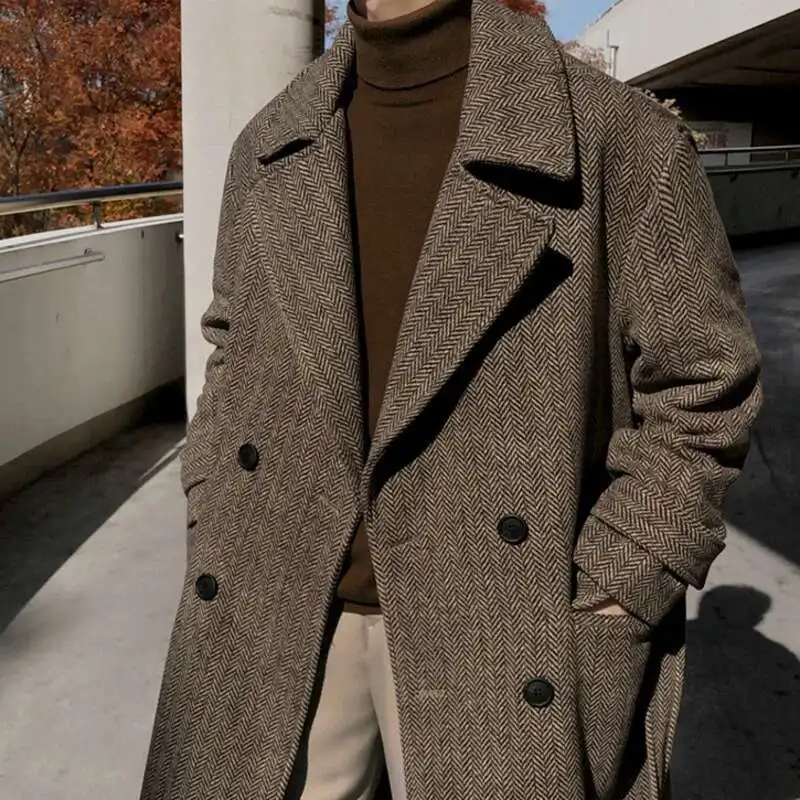
Coordinating Your Ensemble
Creating visual harmony between overcoat and accessories requires thoughtful color and texture relationships:
- Complementary colors: Select accessories in hues that enhance your coat’s color rather than exactly matching it
- Texture contrast: Pair smooth-finished coats with more textured accessories (and vice versa) for visual interest
- Pattern management: When incorporating patterns, maintain proportion relationships—smaller patterns for accessories with solid coats; solid accessories with patterned coats
The most sophisticated combinations create visual relationships that appear intentional rather than coincidental.
Practical Considerations
Beyond aesthetics, functional coordination enhances real-world performance:
- Coverage optimization: Ensure scarf length allows proper neck protection without excessive bulk inside the coat
- Layering logic: Coordinate hat styles with coat collar height and design for comfortable overlap
- Material harmony: Align accessory insulation levels with coat weight for balanced protection
Well-chosen accessories should enhance rather than compromise your overcoat’s performance while creating a visually cohesive winter presentation.
Conclusion
The perfect winter overcoat represents far more than mere protection from the elements—it embodies the ideal balance of practical function and refined style. Throughout this guide, we’ve explored the multifaceted considerations that inform this important investment, from classic styles and premium materials to proper fit and thoughtful maintenance.
When selecting your winter overcoat, remember to prioritize the elements most relevant to your specific needs: fabric weight appropriate for your local climate, style suitable for your typical activities, and proportions that flatter your unique physique. Understanding the right coat length for your body creates a foundation for success in this significant wardrobe decision.
Quality overcoats reward investment through years of reliable service and timeless style. By focusing on superior materials, thoughtful construction, and proper maintenance, you ensure your chosen garment will serve faithfully through countless winter seasons—potentially becoming a cherished piece passed to future generations.
Whether you’re selecting your first quality overcoat or adding to an established collection, apply the principles outlined here to make confident, informed choices. The perfect winter overcoat awaits—combining protection, style, and quality in proportions perfectly suited to your individual needs and preferences.

